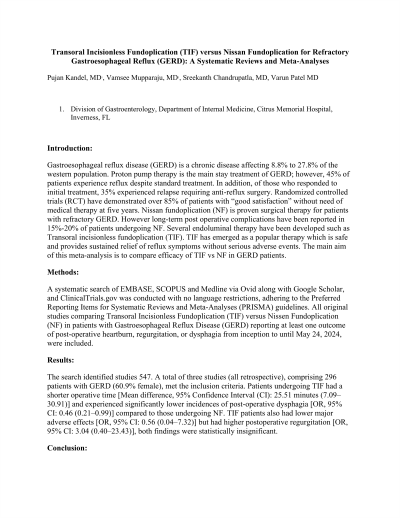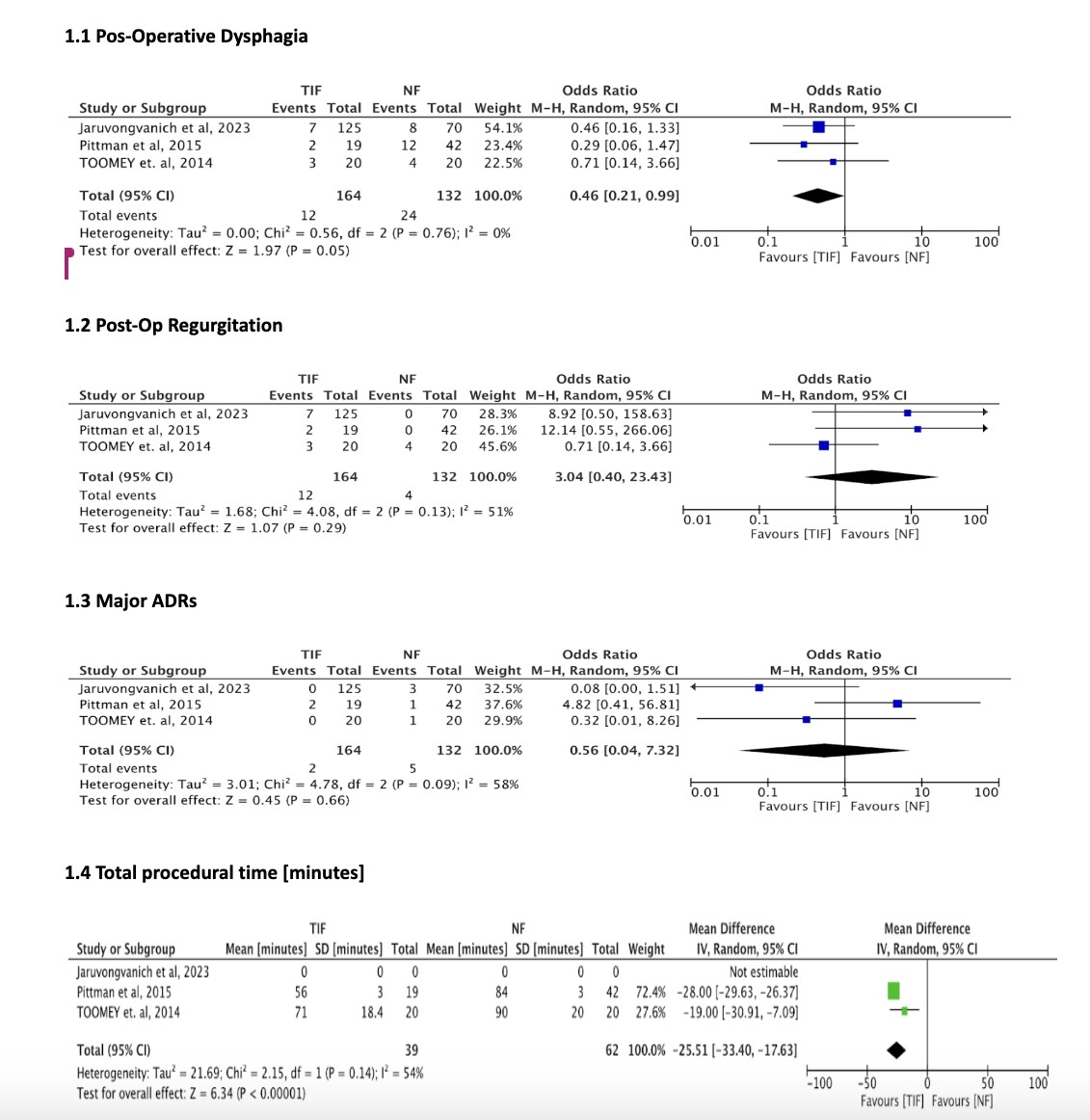Tuesday Poster Session
Category: Esophagus
P3930 - Efficacy of Transoral Incisionless Fundoplication (TIF) vs Nissan Fundoplication for Gastroesophageal Reflux (GERD): A Systematic Reviews and Meta-Analyses
Tuesday, October 29, 2024
10:30 AM - 4:00 PM ET
Location: Exhibit Hall E

- PK
Pujan N. Kandel, MD
HCA Florida Citrus Memorial Hospital
Hernando, FL
Presenting Author(s)
Pujan N. Kandel, MD1, Tapendra koirala, MD2, Deepa Wosti, MD3, Vamsee Mupparaju, MD4, Sreekanth Chandrupatla, MD5, Varun Patel, MD5
1HCA Florida Citrus Memorial Hospital, Hernando, FL; 2Louisiana State University School of Medicine, Shreveport, LA; 3HCA North Florida Hospital, Gainesville, FL; 4HCA Florida Healthcare Citrus Memorial Hospital, Inverness, FL; 5HCA Florida Citrus Hospital, Inverness, FL
Introduction: Gastroesophageal reflux disease (GERD) is a chronic disease affecting 8.8% to 27.8% of the
western population. Proton pump therapy is the mainstay treatment of GERD; however, 45% of
patients experience reflux despite standard treatment. In addition, of those who responded to
initial treatment, 35% experienced relapse requiring anti-reflux surgery. Randomized controlled
trials (RCT) have demonstrated over 85% of patients with “good satisfaction” without need of
medical therapy at five years. Nissen fundoplication (NF) is proven surgical therapy for patients
with refractory GERD. However long-term post operative complications have been reported in
15%-20% of patients undergoing NF. Several endoluminal therapies have been developed such
as Transoral incisionless fundoplication (TIF). TIF has emerged as a popular therapy which is
safe and provides sustained relief of reflux symptoms without serious adverse events. The main
aim of this meta-analysis is to compare efficacy of TIF vs NF in GERD patients.
Methods: A systematic search of EMBASE, SCOPUS and Medline via Ovid along with Google Scholar,
and ClinicalTrials.gov was conducted with no language restrictions, adhering to the Preferred
Reporting Items for Systematic Reviews and Meta-Analyses (PRISMA) guidelines. All original
studies comparing Transoral Incisionless Fundoplication (TIF) versus Nissen Fundoplication
(NF) in patients with Gastroesophageal Reflux Disease (GERD) reporting at least one outcome
of post-operative heartburn, regurgitation, or dysphagia from inception to until May 24, 2024,
were included.
Results: The search identified a total of 547 studies. A total of three studies (all retrospective), comprising
296 patients with GERD (60.9% female), met the inclusion criteria. Patients undergoing TIF
experienced significantly lower incidences of postoperative dysphagia [OR, 95% CI: 0.46
(0.21–0.99)] and had a shorter operative time [Mean difference, 95% Confidence Interval (CI):
25.51 minutes (7.09–30.91)] than compared to those undergoing NF. TIF patients also had lower
major adverse effects [OR, 95% CI: 0.56 (0.04–7.32)] but had higher postoperative regurgitation
[OR, 95% CI: 3.04 (0.40–23.43)], both findings were statistically insignificant.
Discussion: In this systematic review and meta-analysis; we found Transoral incisionless fundoplication to
have shorter operative time, lower incidence of postoperative dysphagia and adverse events
compared to Nissen fundoplication.

Disclosures:
Pujan N. Kandel, MD1, Tapendra koirala, MD2, Deepa Wosti, MD3, Vamsee Mupparaju, MD4, Sreekanth Chandrupatla, MD5, Varun Patel, MD5. P3930 - Efficacy of Transoral Incisionless Fundoplication (TIF) vs Nissan Fundoplication for Gastroesophageal Reflux (GERD): A Systematic Reviews and Meta-Analyses, ACG 2024 Annual Scientific Meeting Abstracts. Philadelphia, PA: American College of Gastroenterology.
1HCA Florida Citrus Memorial Hospital, Hernando, FL; 2Louisiana State University School of Medicine, Shreveport, LA; 3HCA North Florida Hospital, Gainesville, FL; 4HCA Florida Healthcare Citrus Memorial Hospital, Inverness, FL; 5HCA Florida Citrus Hospital, Inverness, FL
Introduction: Gastroesophageal reflux disease (GERD) is a chronic disease affecting 8.8% to 27.8% of the
western population. Proton pump therapy is the mainstay treatment of GERD; however, 45% of
patients experience reflux despite standard treatment. In addition, of those who responded to
initial treatment, 35% experienced relapse requiring anti-reflux surgery. Randomized controlled
trials (RCT) have demonstrated over 85% of patients with “good satisfaction” without need of
medical therapy at five years. Nissen fundoplication (NF) is proven surgical therapy for patients
with refractory GERD. However long-term post operative complications have been reported in
15%-20% of patients undergoing NF. Several endoluminal therapies have been developed such
as Transoral incisionless fundoplication (TIF). TIF has emerged as a popular therapy which is
safe and provides sustained relief of reflux symptoms without serious adverse events. The main
aim of this meta-analysis is to compare efficacy of TIF vs NF in GERD patients.
Methods: A systematic search of EMBASE, SCOPUS and Medline via Ovid along with Google Scholar,
and ClinicalTrials.gov was conducted with no language restrictions, adhering to the Preferred
Reporting Items for Systematic Reviews and Meta-Analyses (PRISMA) guidelines. All original
studies comparing Transoral Incisionless Fundoplication (TIF) versus Nissen Fundoplication
(NF) in patients with Gastroesophageal Reflux Disease (GERD) reporting at least one outcome
of post-operative heartburn, regurgitation, or dysphagia from inception to until May 24, 2024,
were included.
Results: The search identified a total of 547 studies. A total of three studies (all retrospective), comprising
296 patients with GERD (60.9% female), met the inclusion criteria. Patients undergoing TIF
experienced significantly lower incidences of postoperative dysphagia [OR, 95% CI: 0.46
(0.21–0.99)] and had a shorter operative time [Mean difference, 95% Confidence Interval (CI):
25.51 minutes (7.09–30.91)] than compared to those undergoing NF. TIF patients also had lower
major adverse effects [OR, 95% CI: 0.56 (0.04–7.32)] but had higher postoperative regurgitation
[OR, 95% CI: 3.04 (0.40–23.43)], both findings were statistically insignificant.
Discussion: In this systematic review and meta-analysis; we found Transoral incisionless fundoplication to
have shorter operative time, lower incidence of postoperative dysphagia and adverse events
compared to Nissen fundoplication.

Figure: Figure 1 Outcomes of TIF vs NF
Disclosures:
Pujan Kandel indicated no relevant financial relationships.
Tapendra koirala indicated no relevant financial relationships.
Deepa Wosti indicated no relevant financial relationships.
Vamsee Mupparaju indicated no relevant financial relationships.
Sreekanth Chandrupatla indicated no relevant financial relationships.
Varun Patel indicated no relevant financial relationships.
Pujan N. Kandel, MD1, Tapendra koirala, MD2, Deepa Wosti, MD3, Vamsee Mupparaju, MD4, Sreekanth Chandrupatla, MD5, Varun Patel, MD5. P3930 - Efficacy of Transoral Incisionless Fundoplication (TIF) vs Nissan Fundoplication for Gastroesophageal Reflux (GERD): A Systematic Reviews and Meta-Analyses, ACG 2024 Annual Scientific Meeting Abstracts. Philadelphia, PA: American College of Gastroenterology.
